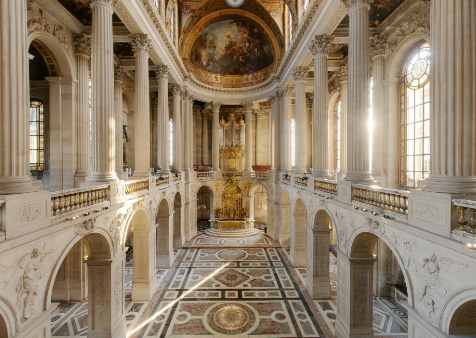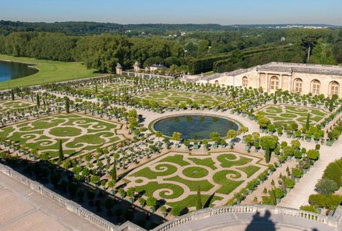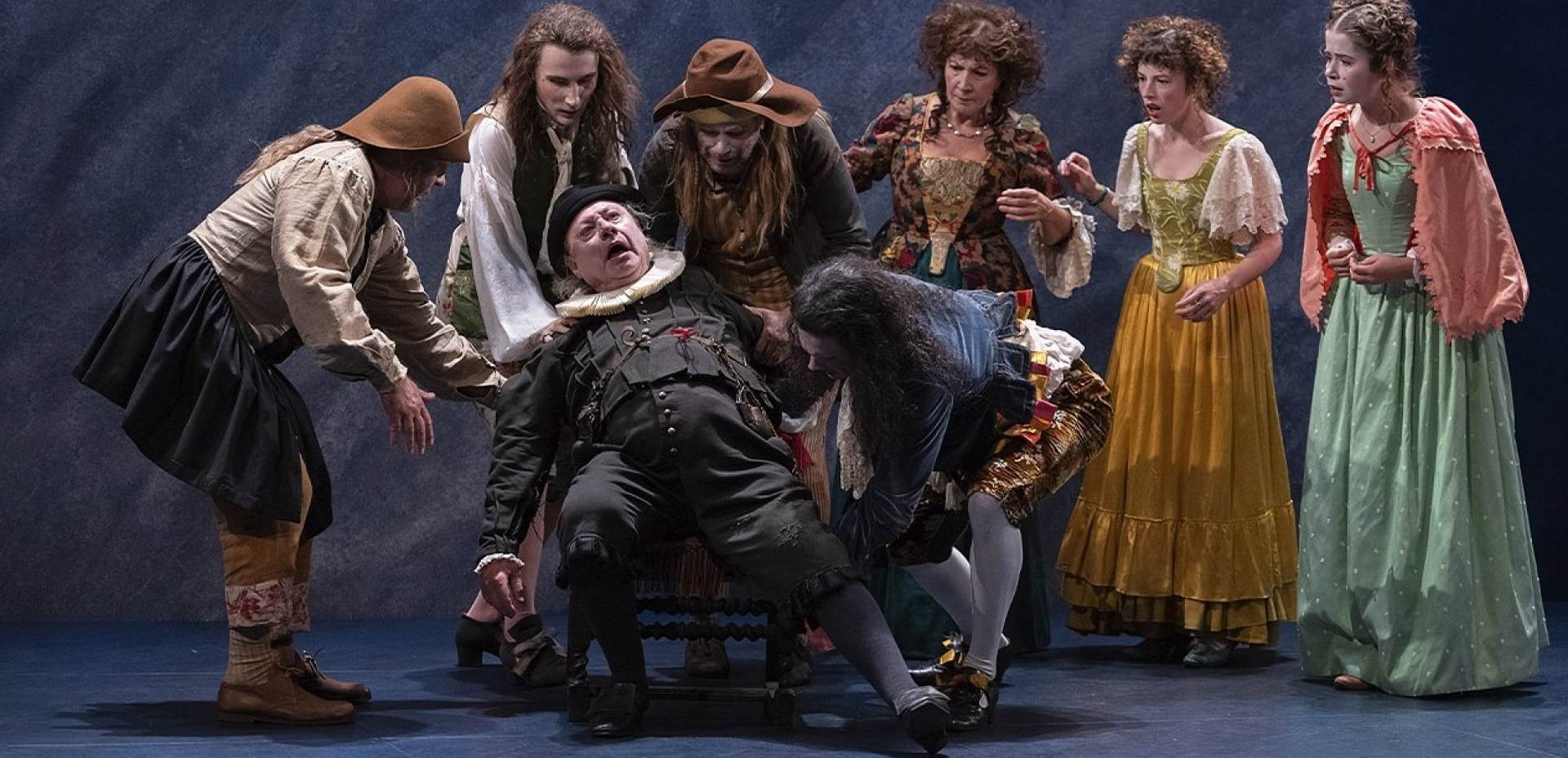Moliere: The Miser
November 2024 | ||||||
|---|---|---|---|---|---|---|
Mo | Tu | We | Th | Fr | Sa | Su |
Comedy in five acts, first performed in Paris in 1668.
Creation on October 6th 2022 at the Théâtre National Populaire de Villeurbanne.
Production : Compagnie Jérôme Deschamps
Coproduction : Théâtre National Populaire, Villeurbanne, Théâtre Montansier,
Versailles, Théâtre de Caen, EPCC Châteaux de la Drôme, Théâtre de Chartres, Scène
Conventionnée d’Intérêt National – Art et Création. With the artistic participation of the
Jeune théâtre national et de la compagnie Mademoiselle. La Compagnie Jérôme
Deschamps is supported by the Ministère de la Culture.
Synopsis
Act I
La Flèche is waiting for his master in Harpagon's house. Valère explains to the audience how he has assumed the role of a servant to be closer to Élise. They met when he rescued her from drowning and they fell in love. Harpagon enters, angry with La Flèche for hanging around. He suspects him of stealing something from him. La Flèche is angry at being suspected and points out that Harpagon is so careful with his money that it would be impossible to steal it. Harpagon confides in the audience expressing anxiety about the large sum of money he has buried in the garden. As Cléante and Élise enter he is again fearful that they might have heard what he is saying about the hidden money. When they approach Harpagon thinks that they are plotting to steal from him. They are actually trying to work out how to broach the subject of marriage with him since they have both found people they want to marry. Harpagon also wants to discuss marriage with them and he mentions a young girl called Mariane. Harpagon wants to know what Cléante thinks of her. Cléante is shocked and rushes off the stage. Meanwhile, Harpagon says that Élise has to marry Seigneur Anselme. Harpagon asks Valère for his opinion on the matter. Valère is trying to suck up and agrees with Harpagon's idea. Valère reassures Élise that somehow they will sort things out later.
Act II
Cléante expresses his frustration that he and his father are rivals in love with the same woman but plans to keep his own sentiments secret while he tries to secure funds to help Mariane and her mother. Cléante has dispatched La Flèche to meet with a money-lender. Maitre Simon has acted as an intermediary between La Flèche and the money-lender until the deal is done so as to protect his identity. La Flèche explains that there are some conditions attached to the loan. Cléante is ready to accept them whatever they are, so long as he can get money to give to his beloved. When La Flèche refers to them as 'several small conditions' it is rather an understatement. Cléante is resentful but feels trapped by his desire for the money. Meanwhile, Maitre Simon enters with Harpagon discussing a young man who wants to borrow from Harpagon. Harpagon is displeased that Cléante is trying to borrow money from someone else. Cléante, dismissed by his father, expresses disgust and leaves.
Act III
The scene begins with Harpagon calling his household together to issue instructions in preparation for Mariane's arrival for dinner. When it is Master Jacques's turn, he wants to know whether he is being consulted as coachman or cook. Master Jacques insists that he can only produce excellent food if given money. Harpagon wants his carriage cleaning and horses getting ready. Mariane enters. She is shocked at how unattractive Harpagon is when they first meet and then even more shocked to be introduced to Harpagon's son, who is no other than the man with whom she is herself in love. Cléante begins complimenting her which makes Harpagon very agitated because to him, Cléante's words sound insulting and offensive. Cléante pays her compliments on his father's behalf and tells her of an expensive array of delicacies and drinks he has arranged. He then insists they takes as a present, the diamond ring on his father's hand. Harpagon becomes angry with Cléante for wasting his money, but hides his anger from Mariane. Élise arrives, is introduced to Mariane, announcing that someone has brought Harpagon some money. Harpagon quickly exits while Cléante and Élise escort Mariane on a tour of the garden.
Act IV
Harpagon sees Cléante kissing Mariane's hand and suspects that something is happening between them. Harpagon wants Cléante to tell him his feelings about Mariane. Cléante expresses a lack of interest in her. Harpagon tricks Cléante into confessing his true feelings by suggesting he is having second thoughts about taking her as his wife, and would have given her to Cléante if he thought that Cléante had any feelings for her. Through further questioning, he establishes that Cléante does feel for her and has visited her a few times. Harpagon is angered when Cléante refuses to stop loving Mariane. Master Jacques is called to judge which of them is right and wrong. On stage, he moves between Cléante and Harpagon, listening to their complaints about each other and taking back to each, the version of the response by the other party that he knows each wants to hear. As Master Jacques leaves, he brings the two men together physically on stage to show their new found accord and then leaves them to a new argument. As they make up, they promise respect and tolerance to one another and say thank you to one another for allowing the other to marry Mariane. It then becomes clear as to what has happened, and the conversation returns to the former state of anger. Harpagon tells Cléante to leave and threatens to disinherit him. La Flèche enters excitedly. He has managed to steal Harpagon's money box.
Act V
In this scene Seigneur Anselme enters. He does not want to force Élise into an unhappy marriage. Master Jacques accuses Valère of stealing Harpagon's gold. When Valère comes in he believes the crime to which Harpagon desires him to confess is the crime of stealing the love of his daughter. When Valère says that he won't deny it and he has no regrets, he refers to loving Élise but Harpagon thinks he's admitting the theft of the money. Harpagon is puzzled. He is furious with Élise for falling for Valère, especially since he believes him to be a thief. Élise tries to justify this love as Valère saved her life, but Harpagon is not interested. Valère reveals that he is the son of a man of high rank, Dom Thomas d'Alburcy from Naples. Anselme says that this cannot be true as the whole family died in a shipwreck. Valère reveals that when the ship went down, he was saved and he recently discovered his father had also survived. On his search for his father he had met, saved, and fallen for Élise and had decided the best way to be near her was to assume the role of servant. Mariane claims him as her long-lost brother. She also survived the wreck with her mother and eventually came to France. Anselme then reveals he is their father. Harpagon's first reaction is to hold Anselme responsible for the theft of his money. He shows no other emotion than greed. Harpagon is wary of letting them marry because of the cost of a wedding. However, Anselme generously offers to pay for everything. Harpagon is more bothered to find out who took his money. Cléante returns to Harpagon and negotiates with him for the right to marry Mariane in return for getting his money back.
Program and cast
VIP CATEGORY: Best seats in house with complimentary glass of champagne and programme.
PRESTIGE CATEGORY: Excellent seats with complimentary glass of champagne and programme.
Bénédicte Choisnet: Elise Lorella
Cravotta: Frosine
Vincent Debost: Maître Jacques
Jérôme Deschamps: Harpagon
Fred Epaud, Anselme: Brindavoine
Hervé Lassïnce: La Flèche
Aurore Lévy: Mariane
Yves Robin: Maître Simon, Dame Claude, le Commissaire
Stanislas Roquette: Cléante
Geert Van Herwijnen, Bastien Chevrot (en alternance): Valère
Jérôme Deschamps: Director
Félix Deschamps Mak: Stage sets
Macha Makeïeff: Costumes and accessories
Bertrand Couderc: Lighting
Damien Lefèvre: Assistant director
Lionel Thomas: Stage Management
Anton Grandcoin: Set design assistant
Alessandro Lanzillotti: Paint assistant
Laura Garnier: Costumes
Emmanuelle Flisseau et Rebecca Barrault: Wig and make-up assistants
Agnès Linais: Accessories
Didier Glibert, Bastien Clarenc: Lighting Management
Marlène Hémont: Dresser
Nicolas Rouleau: Sound
Les ateliers du TNP: Set construction and costume design (production manager: Julia Lenze)
Palace of Versailles Opera Theater
Royal Opera
The Royal Opera of Versailles, located in the grounds of the Castle, one of the major opera houses.
The opening of the opera house at Versailles brought to a close a process of planning, projects and designs that had lasted for nearly a century. While the Royal Opera was finally built towards the end of the reign of Louis XV, it had been envisaged since as early as 1682, the year when his predecessor Louis XIV took up residence at Versailles. The King had commissioned Jules Hardouin-Mansart and Vigarani to draw up plans for a ballet theatre. Mansart shrewdly decided on a position at the far end of the new wing that was to be built over the coming years: the nearby reservoirs for the gardens’ fountains could be used to fight any fire that might break out, while the sloping ground on that part of the site would allow provision of the necessary technical spaces below the stage without major excavation work. So cleverly-chosen, indeed, was the planned location that none of Mansart’s successors ever questioned it.
Major building work was already under way in 1685, but was soon interrupted because of the wars and financial difficulties which beset the later part of the king’s reign. Louis XV in his turn was long put off by the huge expense involved in the project. As a result, for almost a century the French court was forced to put up with a makeshift theatre installed below the Passage des Princes. When a grand opera was required, with a large cast and complicated stage machinery, a temporary theatre would be built in the stables of the Grande Ecurie, with the entire structure being demolished once the performances were over. This temporary solution was adopted, for instance, during the celebrations of the Dauphin’s wedding in February 1745, but its inconvenience was so starkly obvious that Louis XV finally resolved to build a permanent theatre, entrusting its design to his first architect, AngeJacques Gabriel.
The process of actually building the new theatre, however, was to take over twenty years. During this lengthy period of construction Gabriel, who had studied the leading theatres of Italy, in particular Vicenza, Bologna, Parma, Modena and Turin, presented a series of different designs to his royal patron, none of which was accepted. Only in 1768, faced with the forthcoming successive marriages of his grandchildren, did the king finally give the order for work to commence. Building progressed steadily and the new opera house was completed in twenty-three months, ready for its inauguration on the 16th of May 1770, the day of the Dauphin’s marriage to the Archduchess Marie-Antoinette, with a performance of Persée by Quinault and Lully.

Royal Chapel
This extraordinary two-level palatine chapel was built by Jules Hardouin Mansart between 1699 and 1708 and completed by Robert de Cotte in 1710.
The paintings on the vaulted ceiling by Antoine Coypel, Charles de la Fosse and Jean Jouvenet, as well as the lavish decoration fashioned by a team of sculptors working for Louis XIV, depict a number of Old and New Testament scenes. Facing the royal gallery is the remarkable organ, created by Robert Clicquot, the King's organ builder, which was first played on Easter Sunday 1711 by François Couperin.
Even though Hardouin-Mansart did not witness the completion of the chapel, he was the one who had dictated the major aspects of the architecture and decor: a ground floor with a nave, aisles and ambulatory, and an upper floor with galleries, a harmonious combination of white and gold contrasting with the polychromatic marble floor and paintings on the vaulted ceiling, all combining to create an original space with references to both gothic architecture and baroque aesthetics.
Every day, generally at 10 a.m., the court would attend the King's mass. The King would sit in the royal gallery, surrounded by his family, while the ladies of the court would occupy the side galleries. The "officers" and the public would sit in the nave. The King would only descend to the ground floor for important religious festivals when he would take communion, for Order of the Holy Spirit ceremonies and for the baptisms and weddings of the Children of France, which were celebrated there between 1710 and 1789. Above the altar, around the Cliquot organ played by the greatest virtuosos of their age, including François Couperin, the Chapel Choir, renowned throughout Europe, would sing motets throughout the entire service, every day.

The Orangerie gardens
From May to October, orange trees and other shrubs are taken out of the Parterre Bas of the Orangerie gardens. At the center of this parterre, there is a large circular pool surrounded by six sections of lawn.
Orangerie
A great stone cathedral within a formal garden, The Orangerie is both a royal and magical place.
Built between 1684 and 1686 by Jules Hardouin-Mansart to house and protect precious trees and shrubs during the Winter, this extraordinarily large building is located beneath the parterre du Midi (South flowerbed), for which it acts as a support. Two monumental staircases, known as "les Cent Marches" (the hundred steps), frame the Orangerie's three galleries, which overlook the parterre where, during the Summer, more than 1,200 exotic trees are arranged.

 EN
EN DE
DE IT
IT FR
FR ES
ES RU
RU JP
JP RO
RO
 Seating plan
Seating plan 





